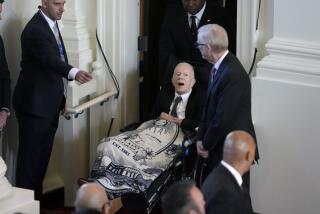Chic Soviet First Lady Not Using the Back Door
- Share via
GENEVA — Nina Khrushchev, the last wife of a Soviet leader to socialize with Americans, is described by Wellesley College Soviet expert Nina Tumarkin as having looked like “a sack of potatoes.”
And, until she appeared at his funeral, it was not widely known that Yuri V. Andropov, the Soviet leader from 1982 to 1984, even had a wife.
Now Raisa Gorbachev, apparently a new breed of Soviet woman, is bursting into the American consciousness.
Accompanying her husband, Soviet leader Mikhail S. Gorbachev, she arrived here Monday in a fur-trimmed coat and hat with a new Mercedes awaiting her. She will have tea with Nancy Reagan here today and Wednesday and will join the American First Lady for a ground-breaking at an International Red Cross museum.
Her impact on America could be even greater than it was in Britain, where the press labeled her “the Bo Derek of the steppes” after she appeared in stylish hairdos and clothes with her husband in London last December, chatting with leaders and diplomats. During a trip to Paris last month, she visited fashion designers and made jokes at parties.
In the Soviet Union, Mrs. Gorbachev sometimes boards and leaves airplanes unnoticed through the rear door while her husband uses the front door. But Monday in Geneva, the Gorbachevs deplaned together--so close together, in fact, that they appeared to have trouble squeezing through the door.
“That Gorbachev shows her, and that she seems chic, is part of the symbolism that the Soviet people are going to enter a new age in which they conduct themselves more by norms of Western civilization,” said Jerry Hough, who teaches Soviet politics at Duke University. “And I think that’s going to be far more important than arms control agreements in affecting Soviet-American relations.”
Americans are suspicious of the Soviets less because of their military might and international adventurism than because of the virtually impenetrable secrecy that surrounds their leaders, Hough said.
“The Soviet Union seems to Americans like a very alien kind of civilization,” he said. “There are no soap operas, no sit-coms and they don’t show their wives in public. It just shows a strange mind-set. Civilized men, when they go abroad, take their wives with them.”
But the experts caution against leaping to unwarranted conclusions on the strength of a few public appearances by the wife of the Soviet leader.
“Americans, unfortunately, equate the trappings of expensive Western culture with liberalism,” Tumarkin said. “When Andropov became the general secretary of the party, people were saying, ‘We have a sense he’s going to be more liberal because he drinks Johnny Walker scotch and listens to Glenn Miller,’ as if that could be a statement about his politics.
“People somehow assume that if Raisa Gorbachev wears Chanel No. 5, she’s a democrat. It’s preposterous.
“The good part is, if she wears Chanel No. 5, she’s human. If we see that they enjoy some of the things we enjoy, we figure at least we can have a dialogue with people like this. They’re not from Mars.”
Tumarkin warned that the Raisa Gorbachev Show is largely for Western consumption. In interviews with 50 Soviet war veterans in the Soviet Union about various domestic issues, Tumarkin found that “no one mentioned her at all. If you look in Pravda and Izvestia, you won’t see her.”
Although the Soviet First Lady is not nearly as visible in her country as Mrs. Reagan is in the United States, Mrs. Gorbachev is seen by the Soviets more than any previous leader’s wife. Even her daughter, Irina, a physician, and 5-year-old granddaughter, Oksana, were uncharacteristically visible while watching two recent Soviet parades, standing in full view of the Western press.
Still, Gorbachev does not parade his wife in front of his own people, Tumarkin said, “because the people don’t expect it. He’s not up for reelection.”
The reason for displaying her to Europe and the United States, Tumarkin said, “is to try to build up political capital with the American public, because our public influences our government a lot more than their public influences their government.
“It’s also a question of ego and vanity. Mrs. Reagan is going to be there, and they’d like a taste of what they don’t get to do in their own country.”
Even former arms control negotiators find reason for hope in the scheduled tea parties between the wives of the American and Soviet leaders, the first such get-togethers in 24 years.
“Of course it has an effect,” said Paul C. Warnke, chief U.S. negotiator in 1977 and 1978. “Each side tends to demonize the other. As a result, it’s sometimes a shock to realize that the people on the other side are people.
“I remember the first time Andrei Gromyko (then the Soviet foreign minister) met (President Jimmy) Carter and Carter turned on his southern charm. Then Miss Lillian (Carter’s mother) said to him, ‘You be nice to my boy,’ and we immediately made progress.
“If Nancy Reagan and Raisa Gorbachev can get together and view one another as mothers and as people interested in style, it can make a big difference in the public’s perception.”
Likewise, Gerard C. Smith, chief U.S. negotiator at the first round of strategic arms talks, is not about to dismiss the wives’ activities as meaningless.
“If one believes that Mrs. Reagan is influential on arms control with her husband and if, as I believe, the Soviets are experts in charming people, then it seems to me that it might strengthen Mrs. Reagan’s feelings that arms control might strengthen her husband’s image,” Smith said.
“It can’t do any harm, and it might be a psychological plus.”
More to Read
Sign up for Essential California
The most important California stories and recommendations in your inbox every morning.
You may occasionally receive promotional content from the Los Angeles Times.













